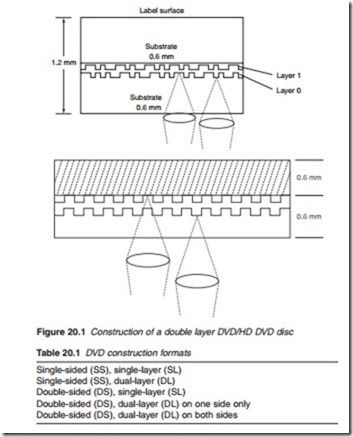DVD
DVD stands for digital versatile disc or more commonly known as digital video disc. DVD is the most recent generation of compact disc (CD) technology able to store huge amounts of data in GB, comparable to the hard disk commonly used in computers. DVD discs are available in two diameter sizes: the commonly used 12 cm and the 8 cm. The 12-cm DVD disc is the same size of the familiar CD (audio or ROM), but holds up to 25 times more data. This takes the DVD to a qualitatively higher level in terms of its application. For the first time, we a have a CD that can hold over 2 hours of high-quality video with six channels of high-fidelity surround sound. Further development introduced the blue-laser based (as opposed to the red-laser based DVD-video) discs, namely ‘HD DVD’ and ‘Blu-ray DVD’ with a capacity of up to 50 GB suitable for up to 9 h of HD video. Apart from video/audio applications, DVD discs may be used for a variety of other applications including archiving of books and still pictures as well as a mass storage device for computer applications and educational/training purposes which make use of interactive facilities.
The first DVD format, DVD-video format was introduced in 1996 with its specifications published in Book B. Previous to that, optical disc tech- nology was limited to the CD and the Laserdisc using a 780 nm wave- length (infra-red) laser beam. The CD had two main formats: audio CD and CD-ROM. The Laserdisc had a 30-cm diameter and was intended to hold high-quality audio and video of up to 1 h per side. That technology never caught on and was quickly superseded by the far superior DVD.
The DVD-video was joined by the DVD-ROM format (Book A) and these were followed by other standards including DVD-Audio, DVD-R, DVD-RAM and DVD_RW. These were followed by the high Density (HD) DVD and the Blu-ray Disc (BD) formats using the shorter 405 nm blue- laser wavelength.
DVD construction
The basic principle of storing data on a DVD is the same as that of the audio CD and the CD-ROM, namely the creation of tiny pits along closely placed spiral track. The pits and the non-pit parts known as lands are translated into ones and zeros by a laser pickup head. Unlike the CD-ROM which has one substrate, the DVD disc consists of two 0.6 mm thick substrates bonded back-to-back (a total of 1.2 mm thickness) giving it the necessary stiffness to avoid disc wobble or tilt.
DVD discs may record data on one side only (single-sided, SS) or on both sided (double-sided, DS). Each side may have a single layer (SL) of recording or two layers (dual-layer, DL) (Figure 20.1). We thus have five different con- struction formats: SS-SL, SS-DL, DS-SL, DS-DL (dual-sided on one side only) and DS-DL (dual-sided on both sides) as listed in Table 20.1. The most popular are the SS discs. Double-sided DVDs have proved to be unpopular with manufacturers and they are not commercially used.
With DL construction, layer 1 must be read through layer 0. Hence, layer 0 must be semi transparent with a reflection of 20% while that of the second layer should have a reflection of 70%. For double-sided discs, data must be read from both sides of the disc.
